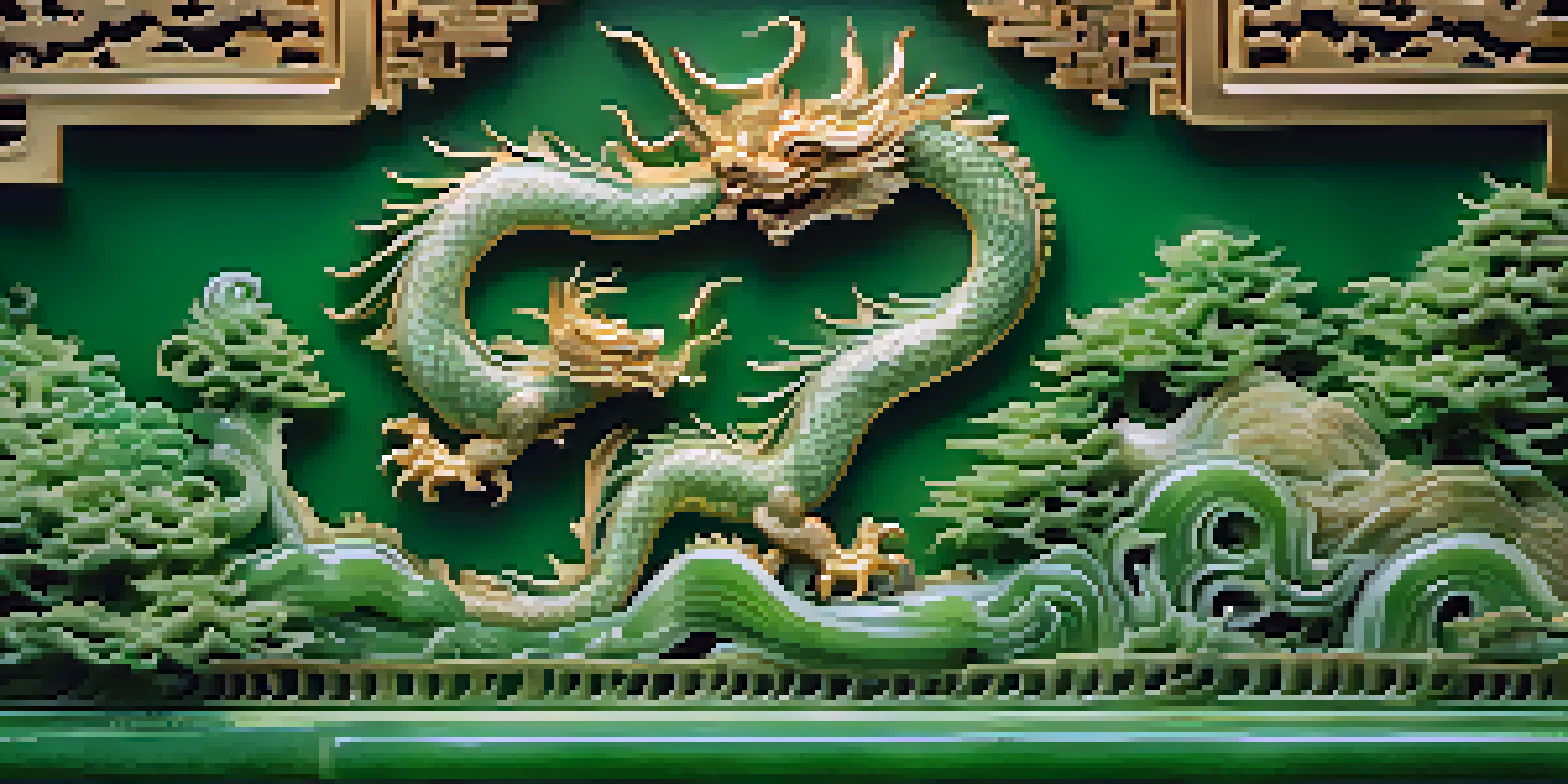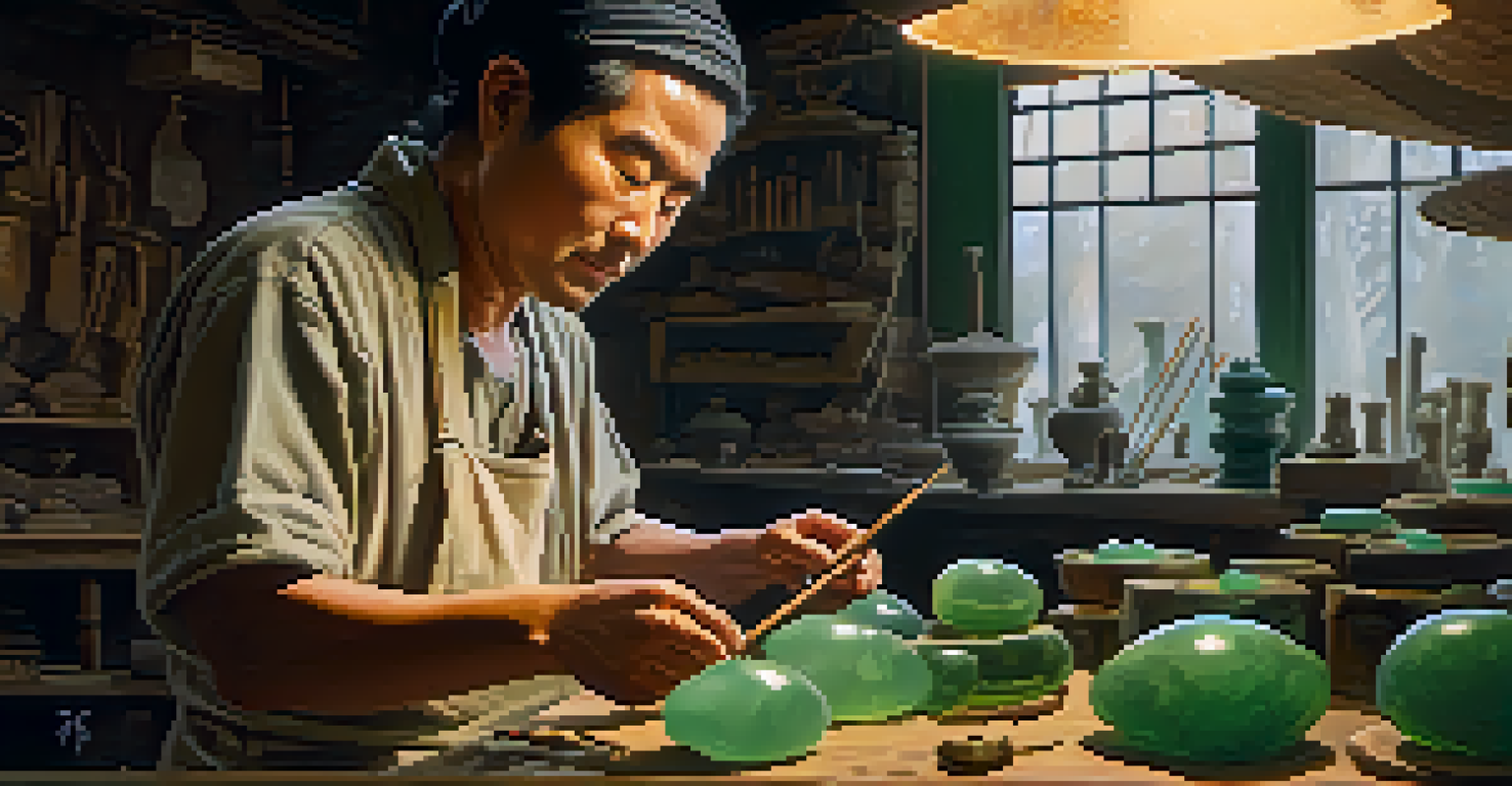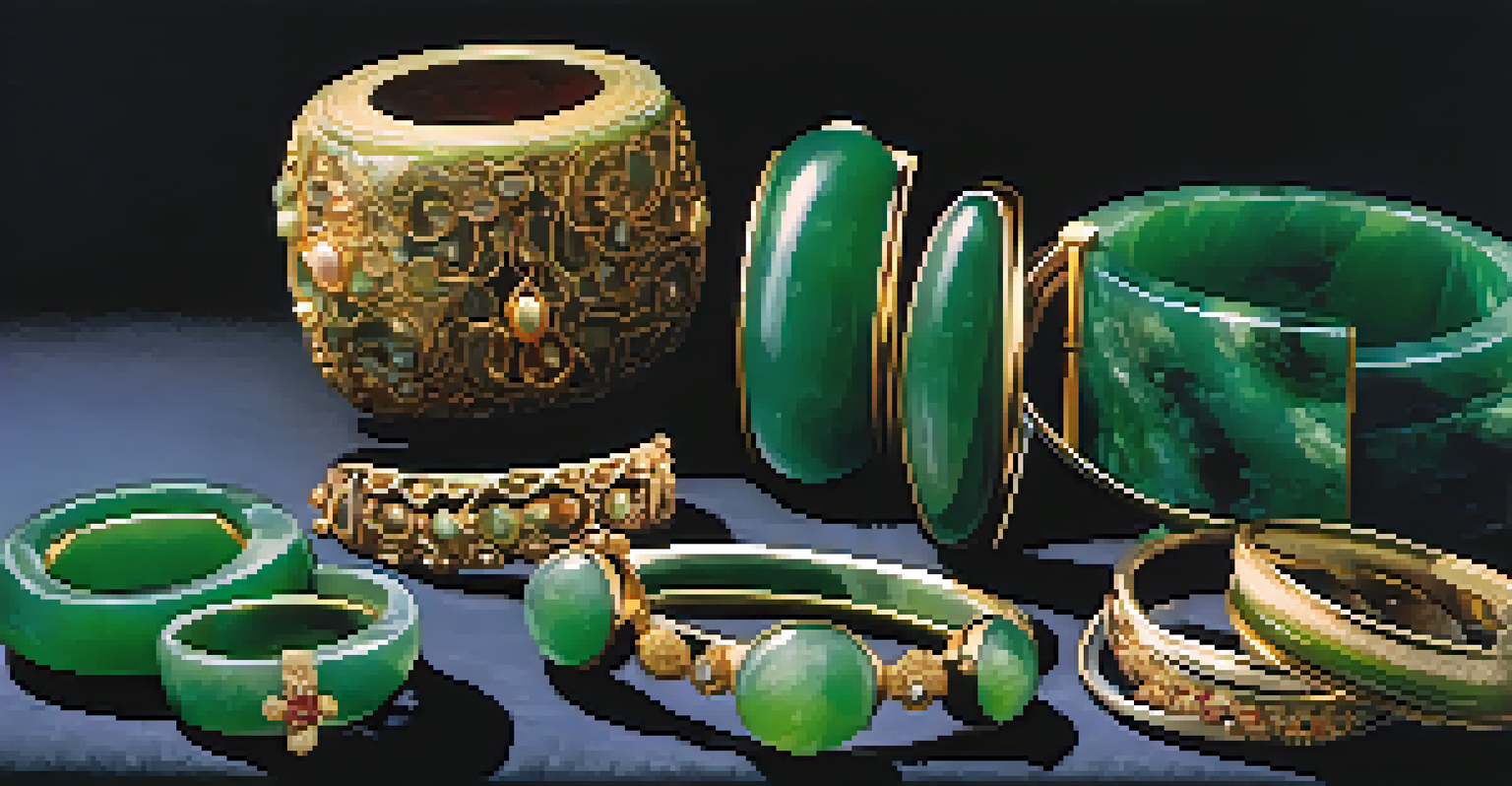Chinese Jade Carving: Techniques and Cultural Significance

The Rich History of Jade in Chinese Culture
Jade has been cherished in Chinese culture for thousands of years, often symbolizing purity, beauty, and moral integrity. Its history can be traced back to the Neolithic period, where it was used to create tools and ornaments. Over time, jade evolved into a material reserved for the elite, reflecting wealth and status in society. The reverence for jade is not just about its aesthetic qualities; it is deeply intertwined with philosophical beliefs and cultural traditions.
Jade is a symbol of purity and moral integrity in Chinese culture, embodying the values that have shaped a civilization for thousands of years.
The ancient Chinese believed that jade possessed protective qualities, making it a popular choice for burial artifacts. Many emperors and scholars sought jade pieces for their supposed powers, which included warding off evil spirits. This connection between jade and the afterlife further solidified its importance in rituals and customs throughout Chinese history. As a result, jade carving became a highly respected craft that was passed down through generations.
Today, jade remains a significant part of Chinese heritage, celebrated in festivals and artworks. Whether in the form of intricate carvings or simple bangles, jade continues to be a symbol of harmony and balance. Understanding its historical context enriches our appreciation of the craft and its enduring significance in Chinese culture.
Understanding Jade: Varieties and Characteristics
Jade is primarily categorized into two types: nephrite and jadeite. Nephrite is the more traditional form, known for its creamy texture and affordability, while jadeite is rarer and prized for its vibrant colors, especially the sought-after imperial green. Each type has unique characteristics that influence how they are carved and appreciated. For instance, jadeite can exhibit a range of colors, from lavender to deep green, adding to its allure in the eyes of collectors.

The qualities of jade, such as its toughness and translucence, play a crucial role in the carving process. A skilled artisan must understand these properties to bring out the best in their material. For example, jade's toughness requires the use of specialized tools like diamond-tipped saws to achieve precise cuts. This level of craftsmanship is essential, as any mistake can compromise the integrity of the piece.
Jade's Cultural Significance
Jade has been a symbol of purity, beauty, and moral integrity in Chinese culture for thousands of years, deeply intertwined with philosophical beliefs and traditions.
Moreover, the beauty of jade is enhanced by its polish and finish. Carved pieces often undergo meticulous polishing to achieve a high sheen, making the stone's natural luster shine through. This attention to detail not only highlights the craftsmanship but also elevates the jade into a work of art that reflects both nature and human creativity.
Traditional Techniques in Jade Carving
Jade carving is an intricate art form that combines traditional techniques with creative expression. One of the most common methods is called 'subtractive carving,' where artisans skillfully remove material to reveal the desired shape. This method requires patience and precision, as jade can be unforgiving if not handled carefully. Each stroke matters, and the artisan's experience greatly influences the outcome.
Every jade carving tells a story, rich with symbolism and deeper meaning, reflecting the virtues cherished by generations.
Another technique involves the use of 'intaglio' carving, where designs are engraved into the surface of the jade. This technique allows for detailed imagery that can tell stories or convey themes important to Chinese culture. For example, motifs like dragons and phoenixes symbolize power and beauty, respectively. By incorporating these symbols into their work, artisans connect with centuries-old traditions while adding their personal touch.
Additionally, the use of modern tools has transformed traditional jade carving. While some artisans still rely on hand tools, many have adopted electric tools to enhance efficiency and precision. This blend of old and new techniques showcases the adaptability of jade carving, allowing it to thrive in contemporary art while honoring its rich heritage.
Symbolism and Meaning in Jade Carvings
Every jade carving tells a story, rich with symbolism and deeper meaning. In Chinese culture, jade is often associated with virtues like wisdom, courage, and justice. Artisans carefully choose motifs that reflect these values, creating pieces that resonate with the viewer on a personal level. For example, a carving of a lotus flower represents purity and spiritual awakening, making it a popular choice for gifts and personal adornment.
Moreover, jade carvings are frequently made to commemorate significant life events, such as births, weddings, or anniversaries. These pieces serve as lasting mementos that celebrate love, hope, and prosperity. The act of gifting jade is considered especially meaningful, as it symbolizes the giver's good wishes for the recipient's future. This practice reinforces the bond between individuals and highlights the cultural importance of jade in fostering relationships.
Varieties and Characteristics of Jade
Jade is primarily categorized into nephrite and jadeite, each with unique qualities that influence carving techniques and aesthetic appeal.
In essence, jade carvings are not mere decorations; they are imbued with cultural significance and personal stories. By understanding the symbolism behind these pieces, we can appreciate the thoughtful artistry and the deep connections they foster within families and communities.
Modern Trends in Jade Carving
In recent years, jade carving has experienced a revival as contemporary artists explore new styles and techniques. This modern approach blends traditional craftsmanship with innovative designs, appealing to a broader audience. Artists are experimenting with different shapes, sizes, and color combinations, pushing the boundaries of what jade carving can be. For instance, abstract forms and minimalist designs are gaining popularity among younger collectors.
Additionally, there is a growing trend toward sustainable and ethical jade sourcing. As awareness of environmental and social issues increases, many artisans are committed to using ethically sourced jade. This shift not only respects the material's cultural significance but also ensures that the craft can be sustained for future generations. Consumers are becoming more conscious of the impact their choices have on the environment, making this trend particularly relevant.
Furthermore, jade carving is increasingly being integrated into modern jewelry design. Contemporary jewelry makers are incorporating jade pieces into their collections, creating stunning combinations of traditional and modern aesthetics. This fusion allows jade to reach a wider audience while ensuring its relevance in today's fashion landscape.
Caring for and Preserving Jade Artifacts
Once you've acquired a beautiful jade carving, understanding how to care for it is crucial for preserving its beauty and value. Jade is relatively durable but can still be susceptible to scratches and damage if not handled properly. It's essential to store jade pieces separately from other jewelry or objects to prevent any potential scratches. A soft cloth or padded jewelry box can help protect these cherished items.
Cleaning jade requires a gentle touch; warm water and mild soap are typically sufficient. Avoid harsh chemicals or ultrasonic cleaners, as they can damage the stone's surface. Regular maintenance can keep jade looking its best, allowing its natural luster to shine through. It's also a good idea to periodically inspect jade pieces for any signs of wear, ensuring they remain in good condition over time.
Modern Trends in Jade Carving
Contemporary jade carving is evolving with innovative designs and a focus on ethical sourcing, appealing to a broader audience while respecting its rich heritage.
Caring for jade is not just about maintenance; it also involves respecting its cultural significance. Understanding the history and symbolism behind your jade carving can enhance your appreciation for it. By treating jade with care and reverence, you honor the artistry and cultural heritage that has been passed down through generations.
The Future of Jade Carving in China and Beyond
As we look to the future, jade carving continues to evolve, blending tradition with innovation. New generations of artisans are embracing the craft, bringing fresh perspectives and ideas to this ancient art form. This dynamism ensures that jade carving remains relevant in a rapidly changing world, appealing to both traditionalists and modern enthusiasts alike. Workshops and art schools are increasingly offering courses in jade carving, helping to cultivate new talent and preserve the craft.
Moreover, the global appreciation for jade has opened doors for international collaborations and exhibitions. Artists from various backgrounds are showcasing their jade carvings, highlighting the universal appeal of this beautiful stone. Such exposure fosters a deeper understanding of jade's cultural significance and the art form itself, bridging gaps between cultures and traditions.

Ultimately, the future of jade carving is bright, as it adapts and thrives in a contemporary context. By honoring its rich heritage while embracing modern influences, jade carving will continue to captivate hearts and minds for generations to come. Its ability to resonate across cultures ensures that jade will remain a treasured material, celebrating both artistry and cultural significance.